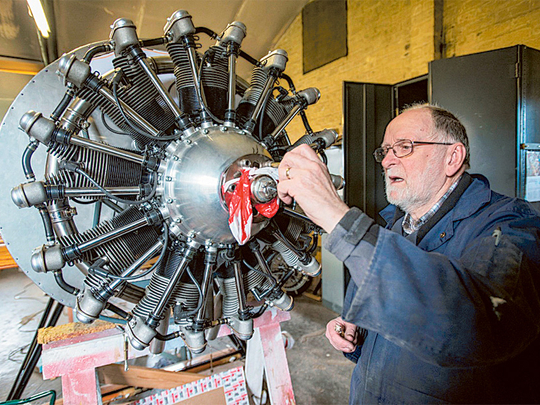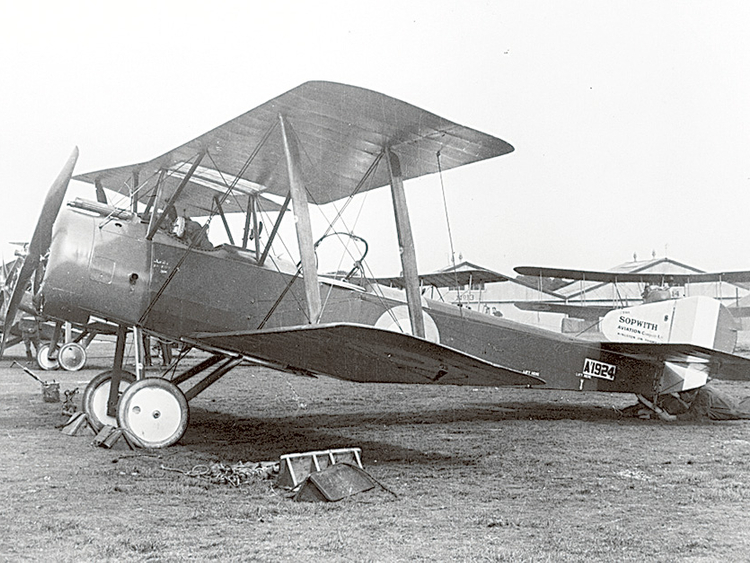
East Lothian, Scotland: In a ramshackle air hangar in a windswept field on the east coast of Scotland, Bernard Ginty, 83, is frowning in concentration at an intricate wooden carving.
“They were an absolute devil to get right,” he says. “But everything has to be exact. We can’t afford any mistakes.”
The tiny carving is actually a wing part for a magnificent replica of one of the first ever first world war fighter planes, the Sopwith 1-1/2 Strutter, designed to counter the German air threat and defend the British coastline from enemy attack.
More than 2,750 other such parts form what amounts to a huge Airfix kit of the plane, currently under construction in the hangar of the National Museum of Flight in East Fortune, East Lothian.
For 13 years, Ginty and his fellow volunteers have devoted their time to rebuilding the 1-1/2 Strutter piece by piece. Next year, on the 100th anniversary of its maiden flight, the men hope their Strutter will take to the skies. Aged between 68 and 93, the 13 volunteers must be among the oldest self-educated aeronautical engineers in the world.
Their skill set ranges from metal work and carpentry to draughtsmanship and radar expertise, though some were simply Meccano enthusiasts as children.
Speaking from their hangar, Ginty explains: “Our goal is to have the aircraft flying by next year. Most men when they retire don’t have giant toys like this to play with. I consider us extremely fortunate to have a place to indulge our hobbies — and decent wives for putting up with us.
Tom Ferguson, a retired Ferranti radar expert, first offered his services as an engineer: “The aircraft had to be built to certain specifications and regulations and I told the boys I would follow the paper trail to keep them on track. But I got fed up sitting on my bottom and seeing them doing the exciting work. So now I do a bit of everything.”
At 82, he still fully intends to test out the plane when it goes up in the air: “If we haven’t got the confidence to go up in it, we can’t have the confidence to build it.”
The team had already spent many years as members of the Aviation Preservation Society of Scotland restoring historic planes such as Tiger Moths, Spitfires and Vulcan bombers for the museum when a former curator suggested they turn their skills to a working replica of a first world war biplane. Initially they looked at the Bleriot, built by a Frenchman of the same name and the first heavier-than-air plane to cross the Channel in 1909. But the unwieldy craft was notoriously tricky to fly and cost many lives in development.
The 1-1/2 Strutter, which spawned the famous Sopwith Camel — the machine that felled the Red Baron, the German flying ace Manfred Von Richthofen — was the next obvious choice, especially given its historical links to the region. The 1-1/2 Strutter was piloted for many years in East Fortune, near Edinburgh, to protect the Royal Navy base in Rosyth, the Forth Road bridge and the Scottish capital from attack.
It was the first plane ever to be launched from an aircraft carrier.
Ginty says: “We have had to learn skills that aircraft builders would have used 100 years ago and there was no one to ask if we were doing it right. We used historical drawings from 1916.”
A particular challenge has been finding parts that were often discontinued decades ago. Ken Sharpe, 72, a former power station engineer, says: “When it was impossible to source these things, we often had to learn how to make them ourselves, to start a little manufacturing line in our garden sheds. Every step was a learning curve.”
The 1-1/2 Strutter was launched in January 1915 by the Sopwith Aviation Company as engineers scrambled to counter the superior aeronautical might of the Germans. The lightweight biplane came hot-on-the-heels of the experimental Sigrist Bus, which had already set a new altitude record.
The Strutter was so-called because its top wings were linked to the fuselage by one long strut and a shorter half strut. Used primarily by the Royal Naval Air Service and the Royal Flying Corps, the prototype biplane was introduced into British service in April 1916. A multi-rolled craft, it was the first to enter military service with a synchronised front-mounted machine gun made by Vickers, using an interrupter gear to fire at the enemy through the propeller. Gerard Lohan, who is making a documentary about the project, said: “German planes could already fire through the propeller which had made them superior, so this was a great advance. It also used airbrakes and had a trimming mechanism so that the balance changed as the fuel, bullets and oil ran out.
“It carried incendiary bullets to help explode Zeppelins and is known to have shot at least one down and scared many away. Most aircraft before this were really out of date.”
Since the machine gun was so intrinsic to the aircraft, the team have been keen to track down an original. If one cannot be found, the plane will be fitted with a realistic-looking alternative. The volunteers are also appealing for help locating authentic cockpit instruments that people may have lying around their homes without knowing their significance, or which may be isolated in museums.
During the war, around 80 per cent of those building the aircraft were women, while the men were away fighting. Their jobs included stitching the linen and painting the bodywork, but they also assembled frames and completed the intricate stringing. The engineering was down to former shipworkers.
None of the women will be alive today but the men want to contact surviving children or grandchildren who may have information or photographs to help them make their craft as realistic as possible.
Sharpe says: “It would be fantastic to get any old photographs or stories passed down the generations from these women. Many died from the toxic paints that were used in those days on the plane: they used to lick their paintbrushes to get a finer finish and it made them ill.”
Among the few compromises on authenticity have been a nine-cylinder engine imported from Australia along with some modern cockpit instruments to comply with stringent Light Aircraft Association licensing regulations.
A plasticised fabric skin is also likely to replace the Irish linen, glue, pins and lacquer of the original. Other considerations surround take-off.
Many of the men have glider pilot licences but are too old to take the machine up independently, which means they are angling for dual controls to be installed.
Sharpe, however, is keenly aware that safety comes first: “A lot of the early planes crashed and killed young pilots who often had no more than six weeks’ training in the rush to get them flying. The engine early on would just conk out. It was a risk, almost like going into space. We now know better and our plane has a modern engine.”
The next step is to find another hangar for the machine, which has outgrown the current space. The whole project has so far cost in excess of £40,000 (Dh54,332), which has come from an initial loan from the museum, private and commercial donations and crowdfunding, and the men will need further financial support to get the Strutter in the air and maintain it.
They hope eventually to take the plane on an international tour for educational purposes. Quinty says: “There will be a few butterflies when we finally see it flying but it will be such a pleasure. Our inspector just keeps saying ‘make it to the specification of the drawings. If it flew 100 years ago, it will fly again.’”













